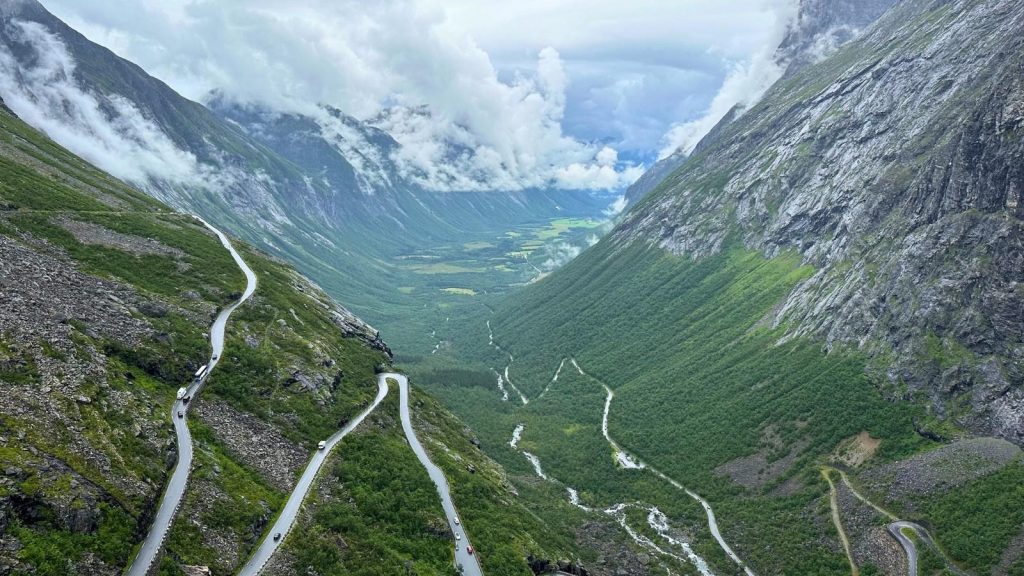Undertaking a Norway road trip is about discovery rather than distance. One moment you’re gliding through a tunnel cut from solid rock, the next you’re parked beside a roaring waterfall watching the spray drift across the road.
The coming year is an ideal time to plan such a trip. Norway’s roads are generally in good condition, with new tunnels and bridges opening up once-remote regions.
The country’s charging network now stretches across the fjordlands and up into the Arctic, making it easier than ever to explore in an electric vehicle. Whether you follow the coast or cross the highlands, every road in Norway leads somewhere unforgettable.
Popular Routes For Norway Road Trips
The biggest challenge when planning a Norwegian road trip is how to choose between so many remarkable routes.
For first-time visitors, a loop around the west Norwegian fjords region showcases Norway’s natural icons. Begin in Bergen and wind north through the Sognefjord and Geirangerfjord regions, then continue to Ålesund for a taste of art nouveau architecture.
Bridges, tunnels and ferries help get around this vast region. Some ferries double as sightseeing cruises, adding a new dimension to any trip.
For those seeking a sense of remoteness, the Arctic Highway from Bodø to the North Cape delivers pure Nordic magic. Island-hop through the Lofoten archipelago, where mountains rise straight from the sea, and continue north beneath the midnight sun or, later in the year, the northern lights.
Alternatively, explore Norway’s quieter heart by exploring the central mountains region between Oslo and Trondheim. The journey passes through deep forests, historic mining towns like Røros and the sweeping Rondane National Park among other highlights.
How To Make The Journey The Destination
If you’re still stuck in the planning phase, the country’s National Scenic Routes are a collection of 18 specially designated roads that highlight landscapes of national importance.
Each route features architect-designed viewpoints and rest areas that blend seamlessly with nature, making them firm favorites among locals and tourists alike. Incorporating two or three of these into your itinerary is sure to result in a memorable trip.
Highlights include the Atlantic Ocean Road, a ribbon of bridges connecting tiny islands, often with waves crashing beside you. Looks familiar? That’s because it’s featured in movies, TV shows and advertisements across the globe for decades.
Cross the Hardangervidda plateau, Europe’s largest mountain plateau, for vast wilderness and reindeer herds. Or tackle Trollstigen, a serpentine road of eleven hairpin bends climbing through misty peaks, one of the country’s most photographed stretches of tarmac.
2026 offers the first opportunity for many visitors to take advantage of the new cafe and restroom facilities at Haukland Beach along the Lofoten scenic route and a new rest stop offering a terrific view of the old stone Måbø bridge on the popular Hardangervidda route.
Plan Practically For 2026
A few smart choices make a road trip smoother. The best months to drive are June through September, when roads are clear and mountain passes open. Spring brings waterfalls at their fullest, while autumn paints the birch forests gold.
Winter and early spring road closures are common, whether for the entire season, overnight for safety, or even limited to convoy driving during heavy snowfall. It’s not a season for the inexperienced motorist.
Car rental is straightforward in all major cities and airports, but summer demand is high, so book well in advance. If you rent an electric vehicle, charging has never been easier. Norway has tens of thousands of public charging points, many of them fast chargers conveniently located near main routes and even in small fjord towns.
Tolls and short ferry crossings are part of everyday travel in Norway. Most rental cars include an AutoPASS tag, which automatically records tolls as you drive. The majority of ferries act as extensions of the road network, so there is no need to book in advance. Simply drive up, wait in line, and board the next departure.
Accommodation in Norway rewards curiosity. Historic manors, seaside rorbuer cabins, rustic lodges and cozy farmhouses invite travelers to slow down and enjoy local food prepared with seasonal ingredients. Most can be found easily on mainstream booking sites.
Coastal towns serve freshly caught cod and mussels, while inland regions highlight reindeer, lamb, berries and artisan cheeses depending on the season.
Distances in Norway can be deceptive. A 200-mile drive might take five hours or more thanks to winding roads and regular stops for ferries or photo breaks. Build in time to linger rather than rush.
Drive carefully and always be prepared for changing weather. Even in midsummer, fog and showers can appear suddenly. Norwegians take pride in their nature, so always park considerately, follow signs and avoid pulling over on narrow shoulders for photos.
Whether you explore the dramatic west coast, the Arctic north or the serene interior, 2026 promises to be an ideal year to take the wheel and discover Norway’s beauty at your own pace, one winding road at a time.

